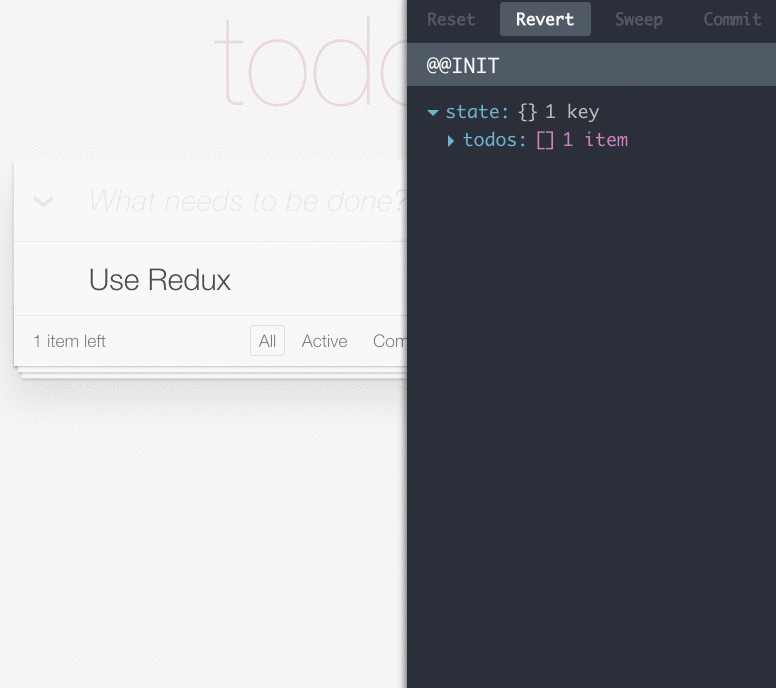redux-meteor
 redux-meteor copied to clipboard
redux-meteor copied to clipboard
An isomorphic template for React and Redux
Build an isomorphic React/Redux app with Meteor
based off thereactivestack's wonderful projects
What you get:
- Much faster dev reloads with webpack HMR. Also, state is preserved through code changes.
- Redux built in. Optionally removable if you don't need it.
- Time travelling debugger and client-side Mongo viewer
Get started
- Update / Install Meteor
-
$ curl https://install.meteor.com/ | sh - Meteor update
- OPTIONAL: install eslint
- fork / clone this repo
- run
meteorin project root
Redux Data flow
Do the time travel thing!

local-only
Use the standard redux data flow
- Write your actions and reducers in a new
client/_reduxfolder
- Don't forget to add it to the combined reducer in
modules/_redux/reducers.jsx - You might want to write everything in a
clientfolder (see faq)
- Use the
connectwrapper to inject the dispatch function and call the action
- See the redux docs
- Check out
client/TodoApp/MainAppp
- Use connect's
mapStateToPropsfunction to get the data in JSX
interacting with the server
- Write a Meteor Method in
methods
- add it to the
methods/server.jsfile - add it to the
methods/both.jsfile for optimistic methods
- Publish the relevant data in the
db/publicationsfile - Write a Tracker.autorun() function
- it shoud contain the subscribe call in it for the relevant data
- it should dispatch an action that updates the store
- Use thunk to call dispatch
- Use connect's
mapStateToPropsfunction to get the data in JSX
Develop
-
CTRL + Hfor redux devtools -
CTRL + Mto view minimongo - OPTIONAL:
meteor add autopublishget the entire db on client
Create a new route
- check out
client/AdminAppfor an example - Add a main route to
Root/routes
Add a client-side NPM module
- find the module name and version on npm
- add it to
webpack.packages.json
Add a server-side NPM module
- find the module name and version on npm
- add the npm module: https://atmospherejs.com/meteorhacks/npm
- follow those instructions!
Create a redux thingy
- See
client/_redux
Publish / subscribe data
- See
db/publications
Use Meteor methods
- See
methods/ - write them as functions!
Code splitting
When developing a huge application, you don't want to serve the entire JavaScript to the client. You might want to wait before he actually need it. This is the problem code splitting is fixing.
Let's say you have a todo application and an admin panel. Do you really want to serve the admin panel to your regular users? With code splitting, you don't need to. Look at modules/AdminApp/client/index.js code to see how it is working. You can copy / paste the same code to create new sections or sub-sections.
The code that is common to multiple sections will be bundled into common.web.js and automatically loaded by react-router-ssr.
The stack & features
from thereactivestack
- Code splitting between parts of your application (dynamiclly loaded only once needed)
- Include the simple todo app example
- ES6 modules
- Meteor
- React.js
- react-router with server-rendering (you can disable it by editing
server/entry.js) - Webpack (bundle your app / assets and send them to Meteor)
- Hot-reload with no page refresh in development mode
- Optimize your code in production mode
- Give access to NPM by using packages.json
Production
You can use meteor run, meteor build, mup or anything working with Meteor.
Run in production mode
enables SSR, no hot reload
meteor run --production
Build for production
meteor build .
Deploy with Meteor-up
mup deploy
FAQ
Why are there so many /client folders?
client folders get hot-reloaded by webpack, without the need for restarting meteor. It's just much faster for development.
Access the store from contexts
React.createClass({
contextTypes: {
store: React.PropTypes.object
}
})
// now access using this.context.store
// or use (props, {store}) => {} + declare contextTypes!
Access store from console
Meteor.store